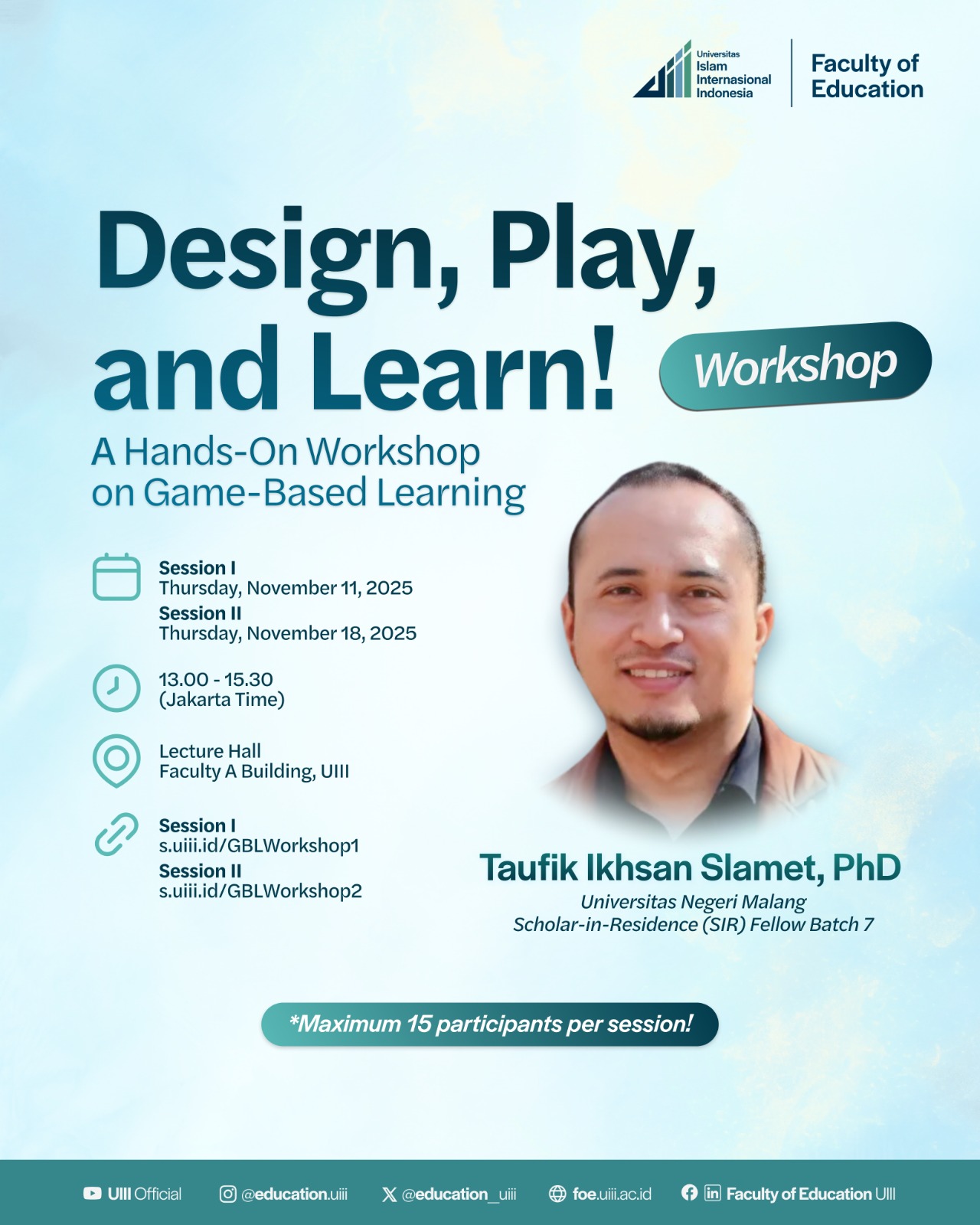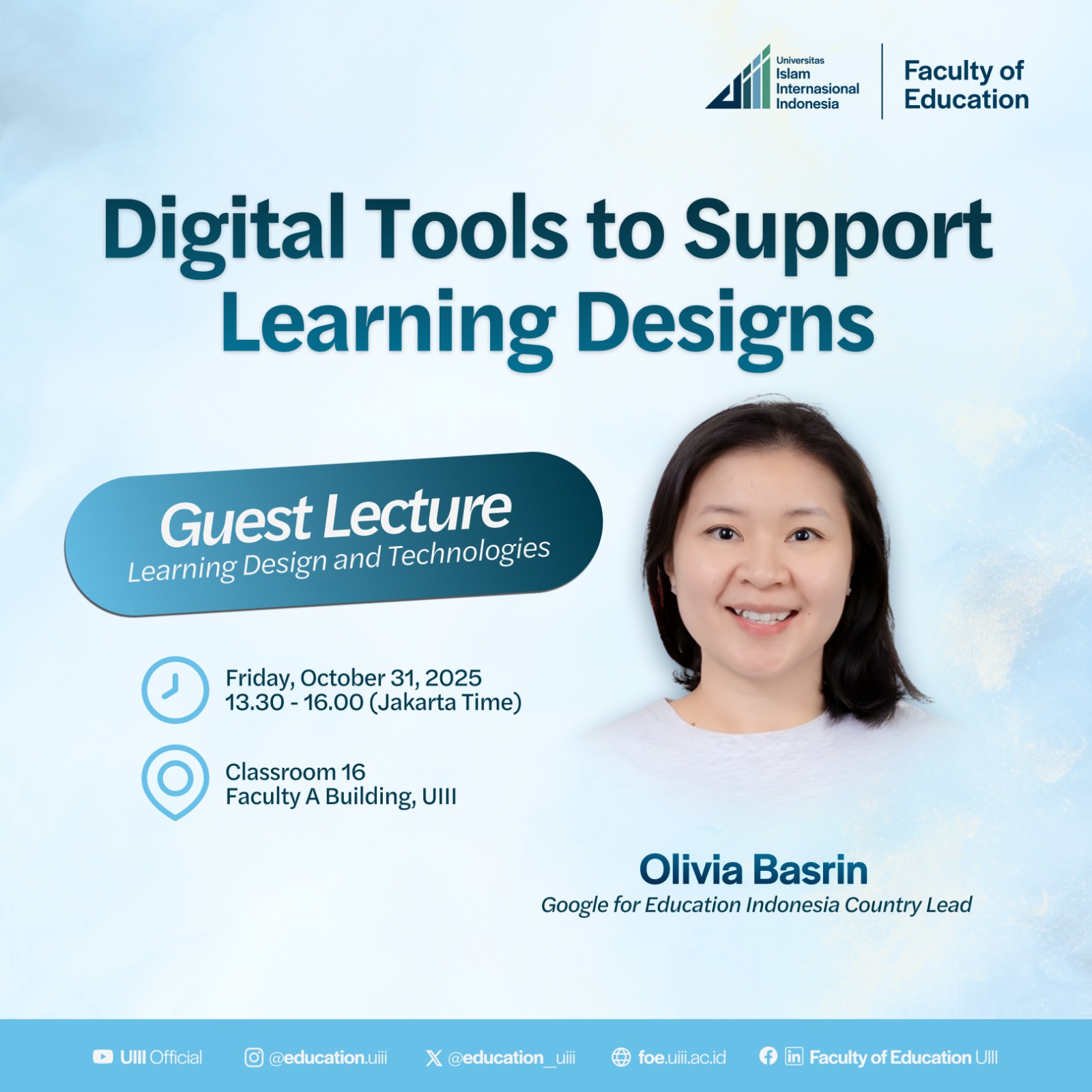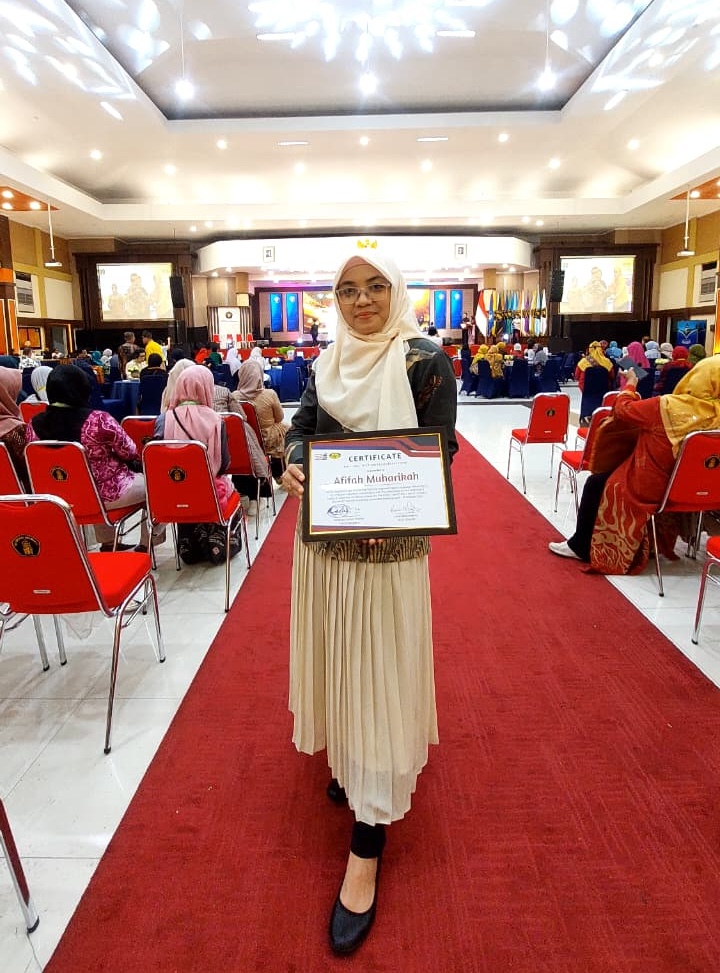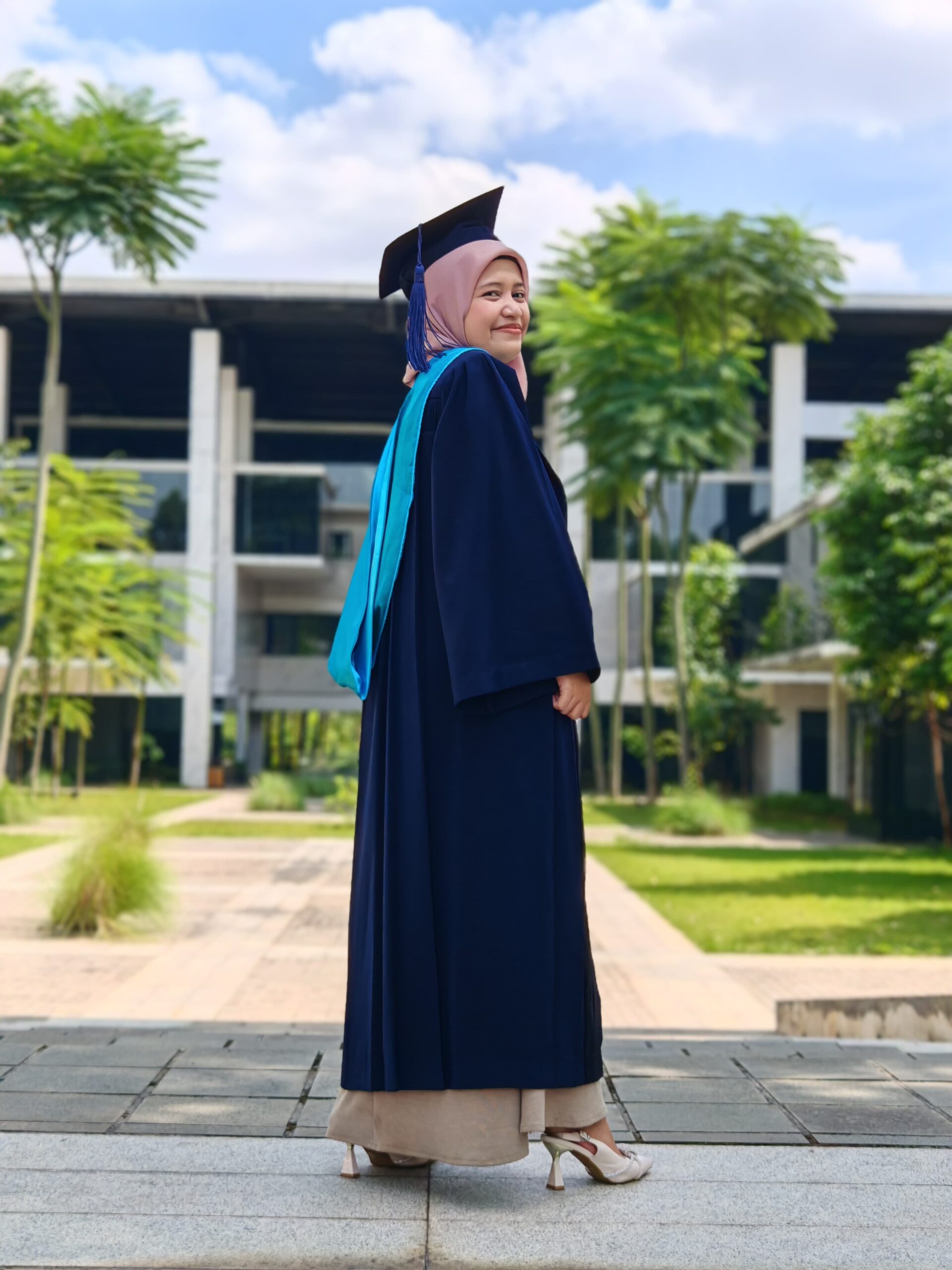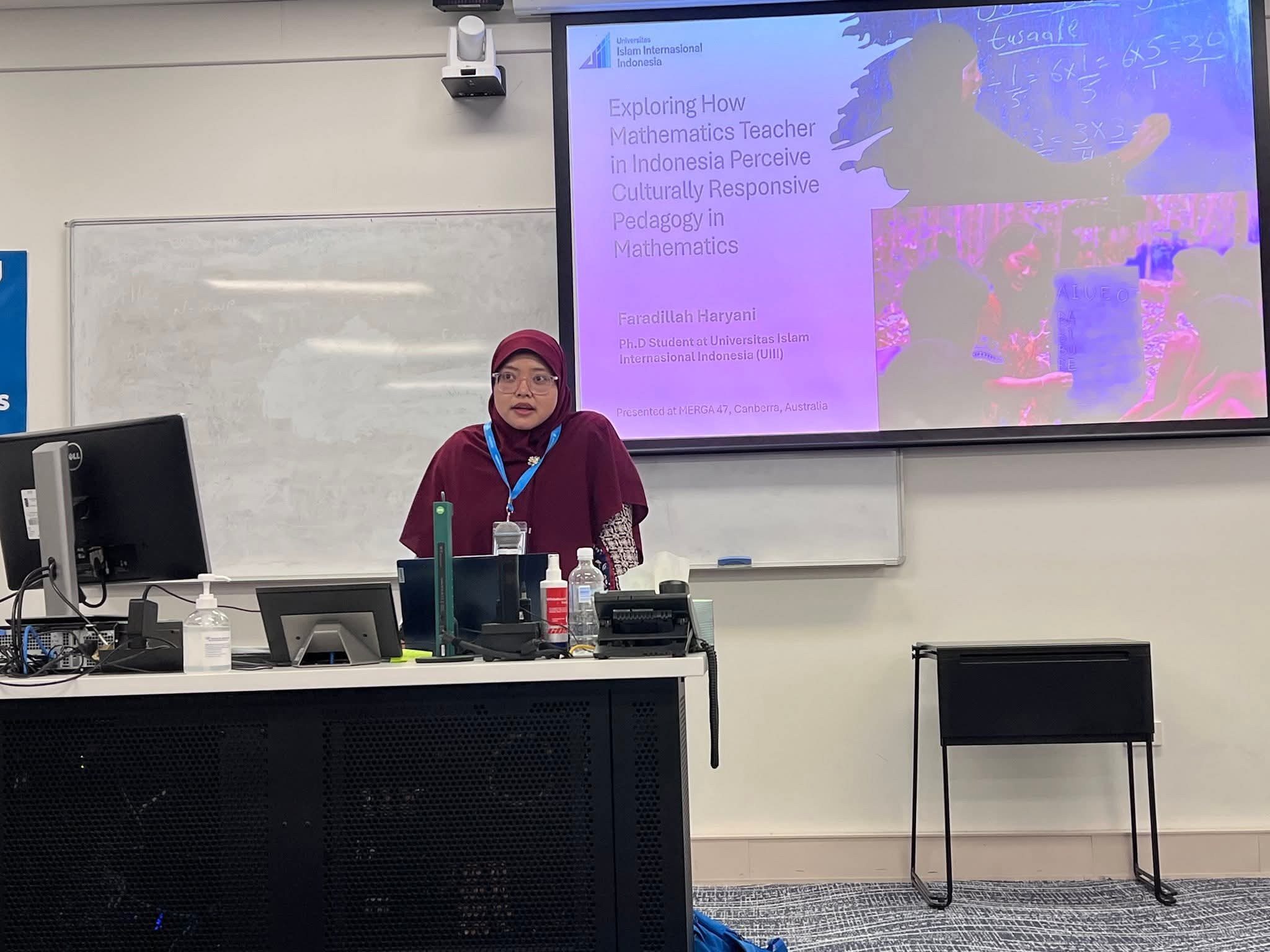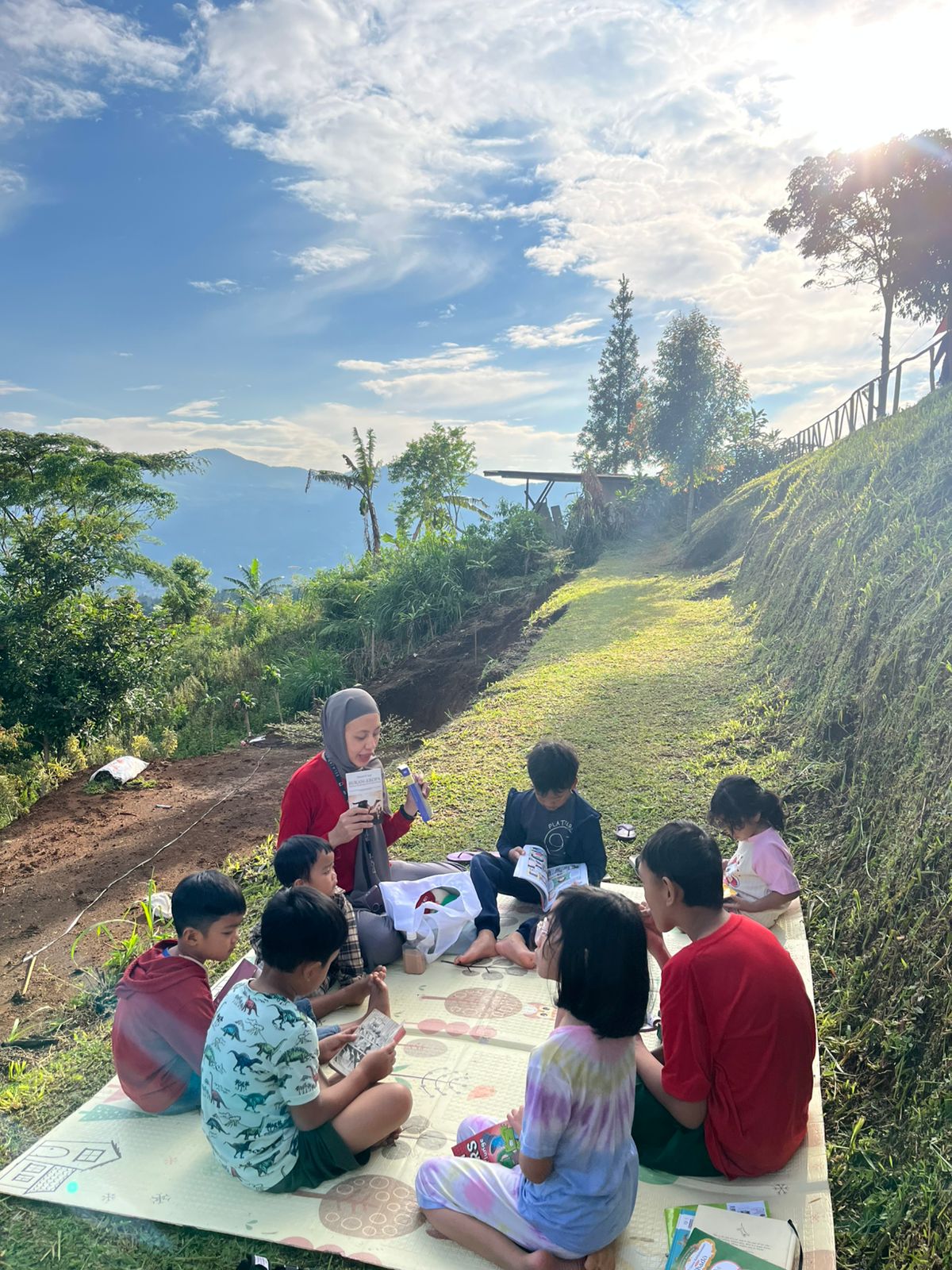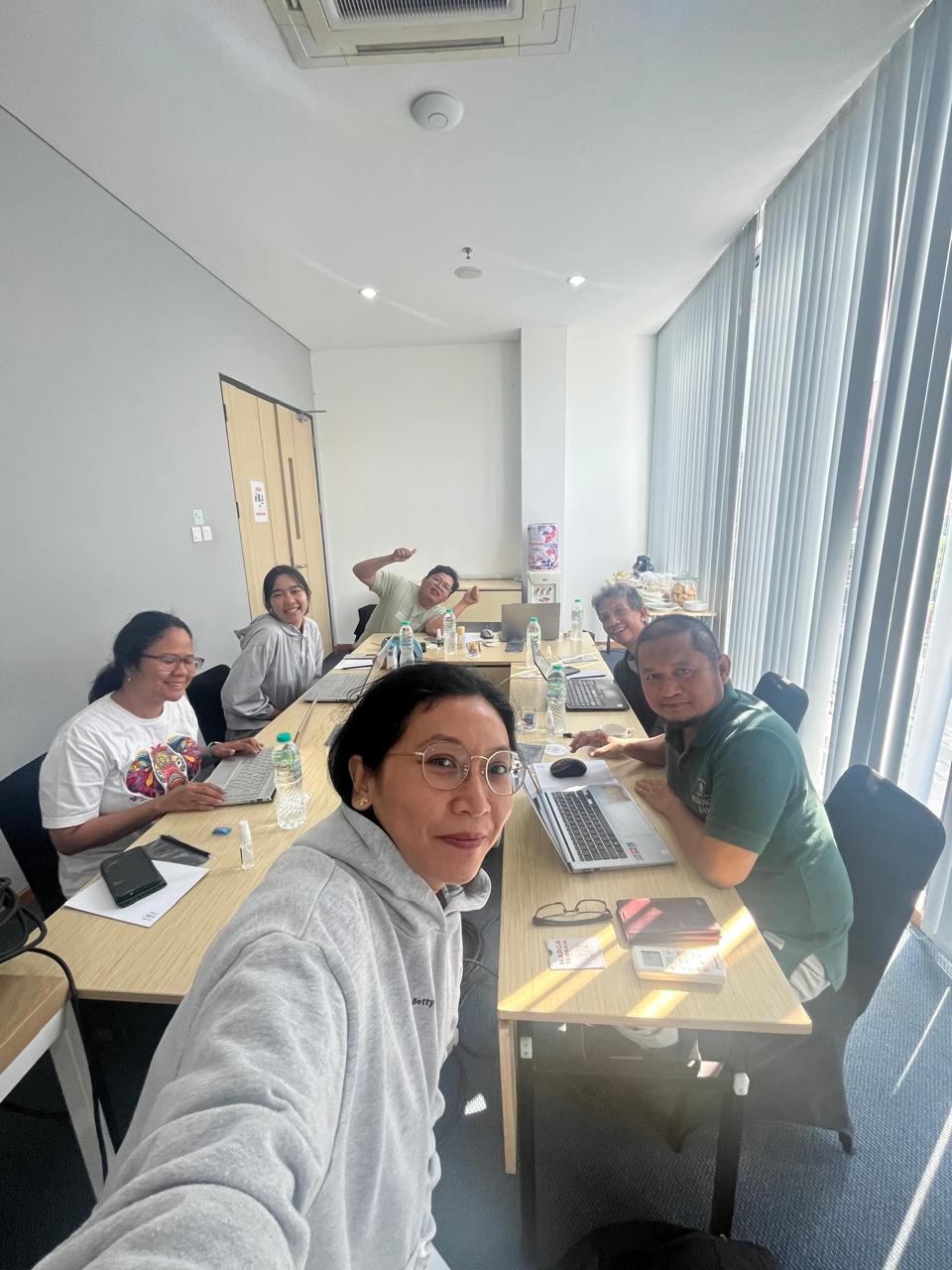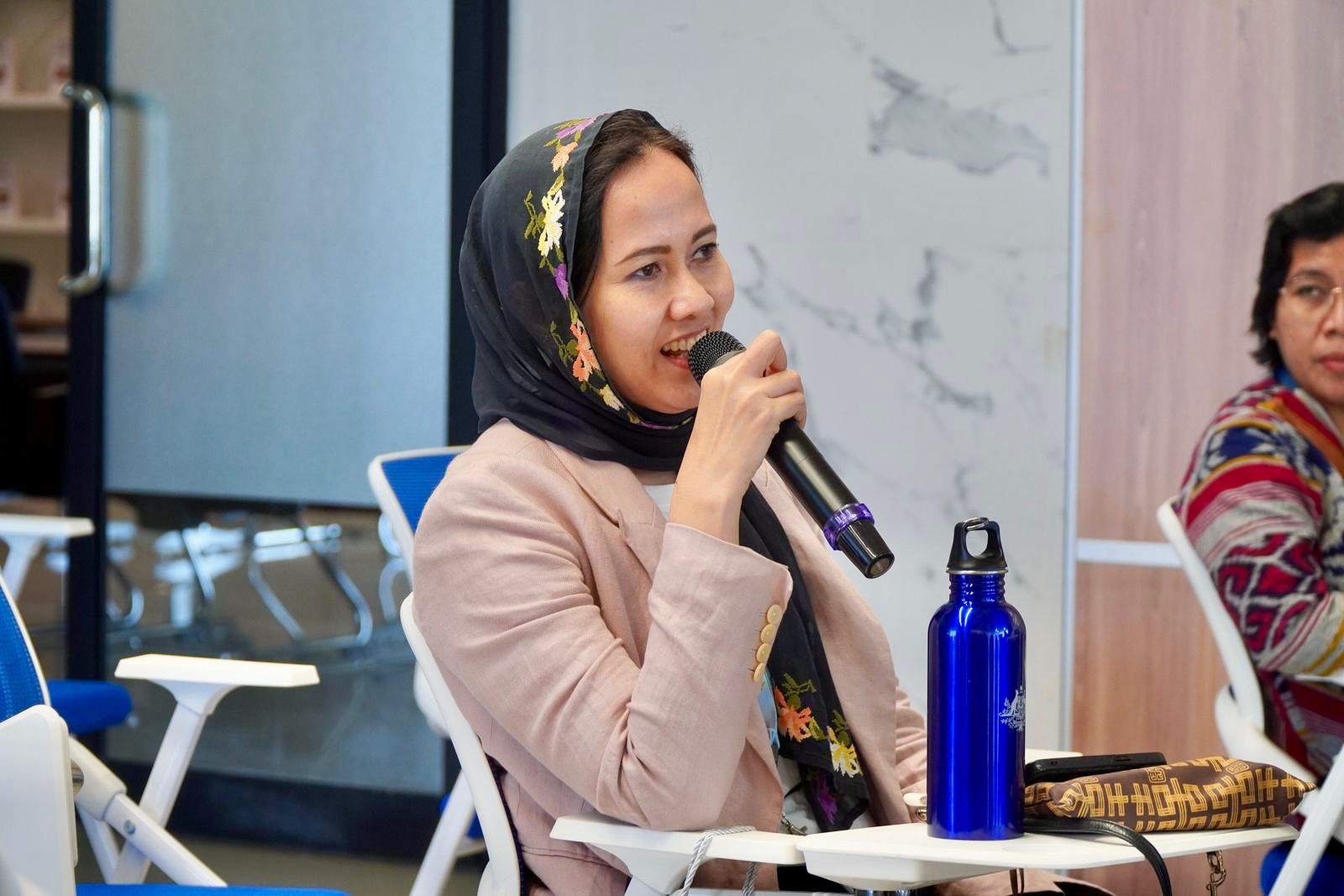Design, Play, and Learn! A Hands-On Workshop on Game-Based Learning

Dear Students
We would like to inform you that the Faculty of Education, UIII, will conduct a workshop with the tittle: "Design, Play, and Learn! A Hands-On Workshop on Game-Based Learning" with Taufik Ikhsan Slamet, PhD.
Details:
Session 1
* Date: Tuesday, November 11, 2025
* Time: 13:00-15:30 (Jakarta Time)
* Place: Lecture Hall, Faculty A UIII
Session 2
* Date: Tuesday, November 18, 2025
* Time: 13:00-15:30 (Jakarta Time)
* Place: Lecture Hall, Faculty A UIII
Limited seats available!
To secure your seat, please fill out the Google Form linked below. Only the first 15 registrants will be accepted.
Link session 1: https://s.uiii.id/GBLWorkshop1
Link session 2: https://s.uiii.id/GBLWorkshop2
Thank you
Guest Lecture: Digital Tools to Support Learning Designs

Guest Lecture (Learning Design and Technologies)
with Olivia Basrin from Google for Education Indonesia Country Lead
Topic: Digital Tools to Support Learning Designs
Day/Date: Friday, 31 October 2025
Time: 13.30-16.00
Place: Classroom 16, Faculty A UIII
This lecture is open for FoE students
UIII Lecturer Receives Prestigious U.S. Embassy’s RELO Scholarship Award at TEFLIN 2025

UIII Lecturer Receives Prestigious U.S. Embassy’s RELO Scholarship Award at TEFLIN 2025
October 16, 2025
Contributor: Supriyono | Photo: Afifah Muharikah
Afifah Muharikah, PhD, a lecturer at the Faculty of Education, Universitas Islam Internasional Indonesia (UIII), has been honored with the prestigious RELO Scholarship Award 2025 during the 71st International Conference of TEFLIN (The Association for the Teaching of English in Indonesia)—one of Indonesia’s most prominent gatherings for English language educators and researchers.
Held under the theme “Reimagining English Language Education in the Age of AI and Digital Transformation: Integrating Inclusive Education and Cultural Diversity,” this year’s TEFLIN conference attracted over 600 presenters and participants from Indonesia and abroad. The event serves as a vital platform for teachers, lecturers, and researchers to exchange ideas and innovations in English education, while fostering global collaboration with international professional networks.
Representing UIII’s Faculty of Education, Dr. Afifah joined the event as one of ten recipients of the RELO Scholarship 2025, an award jointly granted by the U.S. Embassy’s Regional English Language Office (RELO) and TEFLIN to recognize educators making meaningful contributions to English teaching and research in Indonesia.
“The award is very meaningful to me because it directly supports my Latsar CPNS (civil servant basic training) project at UIII,” said Dr. Afifah. “Under the guidance of Prof. Nina Nurmila, Dean of the Faculty of Education, I’m developing an AI Literacy Module for Research, which will later be integrated into the Thesis Preparation course and the Faculty’s Thesis Handbook.”
Throughout the three-day conference, Dr. Afifah participated in sessions that explored topics such as AI in academic writing, digital ethics, inclusive pedagogy, and intercultural communication. She also networked with educators and researchers from various universities and institutions across Indonesia, exchanging ideas about how AI and inclusivity are shaping English language education globally.
Her engagement extended beyond participation — she also took the opportunity to introduce UIII’s programs and share information about the Faculty of Education’s upcoming academic seminar in April 2026, which is currently calling for paper submissions.
“This conference allowed me to reconnect with the TEFL community after completing my PhD and to learn how current discussions on AI, inclusion, and accessibility are influencing English education,” she reflected. “It also helped me transition from practitioner to researcher and strengthen UIII’s academic visibility in the field.”

The RELO Scholarship Award 2025 marks a milestone in Dr. Afifah’s professional journey, following her involvement in previous TEFLIN and RELO-supported programs such as the TEFLIN Professional Development Program and the Developing and Teaching Academic Writing Course (DATAWC).
Dr. Afifah’s recognition not only enhances her personal capacity as an educator and researcher but also contributes to UIII’s broader mission of advancing ethical, inclusive, and globally informed scholarship. This award reflects UIII’s commitment to developing educators who are ethical, competent, and globally connected.
The Process Was Not Easy, but I Did It: A Thesis Writing Journey as an Outsider

The Process Was Not Easy, but I Did It: A Thesis Writing Journey as an Outsider
By Queen Salsabila
Writing a thesis is a final requirement for us, the last year students of Universitas Islam International Indonesia (UIII), to obtain our Master of Arts in Education degree. Writing it was not an easy task; we put our effort, spirit, and dedication into it. We all had our own struggles to finish it, and for me, doing it as an outsider made the journey even more challenging yet memorable. My thesis discusses the role of empathy as the mediator between the effect of collective teachers’ efficacy and school climate on the well-being of English teachers in the special region of Jakarta. As someone who was born, raised, and finished a bachelor’s degree in East Java, I had no personal connection with my field research site or its people when I began my research.
Some people may wonder why I did not make it easier by going to my hometown and doing the research there. However, after considering everything, particularly the uniqueness and diversity of culture in Jakarta, which will add special value for my research topic, I chose Jakarta as my research site. Thus, with that belief and support from my supervisors, I took the big risk of choosing Jakarta as my research site and put East Java as my second plan. This journey was full of self-doubt, fear, tears, and overthinking, but I kept going, believed that I would face it, and in the end, it was all worth it.
Along the way on this journey, despite all my doubts, I always believed that I could do it. At the first step, as an outsider, I had to build everything from scratch. In detail, because my research is quantitative, it requires a lot of participants. Thus, I began my journey by looking for any teacher who could help me become a research assistant. This process was not smooth, because my research participants are English teachers in Jakarta, I began by checking the Instagram account of the English Language Teachers Association (MGMP), but I could not find any active account. I continued my journey by asking some friends who became English teachers, through this way, I got one of the contacts of an English teacher, who is fortunately one of the treasures of MGMP in Pasar Minggu sub-district in South Jakarta. I went to her school to meet her and explain my research topic, and she agreed to be my research assistant.
Furthermore, to obtain legal permission, I went to the Jakarta Provincial Education Office to submit a research permit letter and request a research recommendation letter to conduct research in Jakarta. Eventough Jakarta is a province, buat actually it is a big metropolitan city, which also Indonesian capital. This process was going smoothly, and they were willing to help me in the process of data collection. Through this, my belief that I can complete this research has increased. However, this feeling did not last long. In the data collection process, it was hard for me to gain the data, even though I had already received help from my research assistant and the educational office to distribute my instrument. Realising that waiting would not help, I found another way. I am seeking help from a more impactful person in the field, who is the head of MGMP in DKI Jakarta, both in Junior and Senior High School. I met them to explain my research, my struggle, and to ask for help. During that meeting, I also got the contact number of the head of the School Principals’ work forum (MKKS), so I contacted and met him. Consequently, my data increased gradually.

Despite that, after weeks of waiting, I have not yet reached my target, while the submission deadline for finishing my research is approaching. A feeling of fear came over me, but I am not stopping here, I try another way. With the help of my best friend, Kak Nabila, I dedicated myself to taking a more direct approach. I visited several schools in person, and we went door to door around schools in Jakarta near Depok, waiting for hours to meet the teacher coordinator or principal. In this journey, I accepted both the warm welcome as well as some rejections. Continuing that, I did follow-ups every three days with the heads of the association, even joining their event to introduce myself, explain my research in the forum, and ask for their help to participate. I also contacted a hundred teachers. And finally, I meet my appropriate number of participants. This process taught me patience, humility, and empathy. I learned to respect every rejection and value the slow progress that builds my resilience.
More than that, the challenge is not stopping; the data analysis process is challenging, as is the data collection process. I made mistakes in my analysis, which led to repeating the analysis process. Here, I strive to continuously learn from my mistakes, which leads me to a deeper understanding about the research process and its analysis. From this journey, I believe that if there is a will, there will be a way. For someone who will follow my step, it will not be easy, but you should remember to be courageous, be persistent, never be tired of trying and learning, keep going even if it is a small step, and remember to believe that you can do it, while also having plan B. In the end, this journey not only shaped my research skills but also my character. It gave me valuable lessons that research could never teach. Lastly, thank you so much to everyone who helped me and supported me during this process, especially my supervisor, Assoc. Prof. Charyna Ayu Rizkyanti, PhD, who have always believed in me and guided me during this process. The Journey was not easy, but I made it.
Two Years, Two Journeys, One Australia: Faradillah’s International Pursuit in Mathematics Education
 Two Years, Two Journeys, One Australia: Faradillah’s International Pursuit in Mathematics Education
Two Years, Two Journeys, One Australia: Faradillah’s International Pursuit in Mathematics Education
October 17, 2025
Contributor: Supriyono | Photo: Faradillah Haryani
For Faradillah Haryani, pursuing a PhD at UIII’s Faculty of Education been more than an academic journey—it has been a story of growth, perseverance, and global connection. In just two years of her doctoral studies, Faradillah has been blessed to travel to Australia twice, both times fully funded, presenting her research at two of the world’s most prestigious mathematics education conferences.
“I never imagined I would attend the largest conference in mathematics education, meet so many prominent figures, and gain such profound insights as an early researcher,” she recalled with gratitude.
Her first academic adventure took her to Sydney in 2024, where she joined more than 2,000 participants at the 15th International Congress on Mathematical Education (ICME)—the largest gathering of mathematics educators in the world. The experience, she said, was transformative.
“I began preparing my manuscript during my very first month as a PhD student at UIII. The process took almost a year—from drafting to securing funding. Alhamdulillah, both my applications for the ICME Solidarity Fund and the UIII Conference Grant were accepted,” she said.
Out of 2,065 speakers, only 197 were awarded the Solidarity Fund, and Faradillah was one of them. For her, the experience was not merely about presenting research—it was about discovering how global conversations in education can challenge, inspire, and reshape local perspectives.
“The conference made me reflect deeply on one question: Whose knowledge are we teaching, and is it relevant to every context? It reminded me of the need to value local wisdom and integrate it with global insights.”
At ICME, Faradillah also connected with renowned scholars, including professors from the University of Auckland, Arizona University, and the Algebra Project in the United States—who shared resources, ideas, and invitations to international research collaborations.
Her second journey came in 2025, when she returned to Australia for the 47th Mathematics Education Research Group of Australasia (MERGA) Conference in Canberra—this time, as an emerging scholar recognized by the international community.
Submitting to MERGA, she explained, was no small feat. Known for its rigorous double-round review process, MERGA’s standard is among the highest in the field. “I started with an early bird submission for early career researchers and received pages of detailed feedback—pointing me to readings I hadn’t considered and urging me to refine my arguments,” she said.
With the guidance of her supervisor, Dr. Destina Wahyu Winarti, Faradillah revised her paper multiple times until it was finally accepted—as a full research paper, MERGA’s most prestigious level of recognition.
 Her efforts did not go unnoticed. She was awarded the MERGA Student Bursary Award, one of only four recipients that year. When her name appeared on the screen during the opening ceremony with the message “Keep your eye on this emerging researcher,” Faradillah could hardly believe it. “It was one of the most humbling moments of my life,” she said.
Her efforts did not go unnoticed. She was awarded the MERGA Student Bursary Award, one of only four recipients that year. When her name appeared on the screen during the opening ceremony with the message “Keep your eye on this emerging researcher,” Faradillah could hardly believe it. “It was one of the most humbling moments of my life,” she said.
Her paper was later selected as one of MERGA 2025 Quick Reads, a collection of the conference’s most highlighted papers, alongside works by plenary speakers and award winners. “It wasn’t just about recognition,” she reflected. “It was about belonging—feeling part of a community that values collaboration over competition.”
At MERGA, she also met distinguished scholars such as Prof. Kim Beswick, President of ICME 15, and Prof. Kay Owens, a leading figure in ethnomathematics and culturally responsive teaching—both of whom offered invaluable feedback for her dissertation on culturally responsive mathematics education.
“From ICME to MERGA, I learned that research is not a lonely path,” she said. “It’s a shared journey across countries and communities, united by the love for learning and teaching.”
Finding the Right Place for a Global Dream
Faradillah was a graduate of University of Birmingham, UK, where she pursued a Master of Science in Mathematic modelling. Her achievements are even more inspiring when you consider her personal circumstances. As a wife and a mother of a five-year-old, pursuing a PhD abroad full-time was not a simple option.
“I chose UIII because I was looking for an international university that feels local,” she said. “Going overseas isn’t always easy when you have a family. But at UIII, I found the same global exposure I had dreamed of—right here in Indonesia.”
She was particularly drawn to the university’s international faculty, global conferences, and research collaborations. “When I looked at UIII’s academic profile and the backgrounds of its lecturers, I knew this was where I wanted to grow. The international environment here truly prepares us to engage globally.”
Looking back, Faradillah offers a heartfelt message to fellow early-career researchers: “Don’t fear feedback. Don’t fear rejection. Keep writing, keep submitting, keep learning. You never know which door will open when you dare to knock.”
Her story is a testament to the transformative power of perseverance, mentorship, and faith. From Depok to Sydney to Canberra, Faradillah Haryani stands as a shining example of how UIII is nurturing scholars who bridge Indonesia to the world—one research paper at a time.
Interweaving Activism and Academics: Reflections on my Educational Journey with UIII
 Interweaving Activism and Academics: Reflections on my Educational Journey with UIII
Interweaving Activism and Academics: Reflections on my Educational Journey with UIII
By Ajeng Satiti Ayuningtyas
For me, education has always been more than just classrooms and textbooks. It is the breath of life, a path to justice, and a bridge that connects us with those who are often marginalized. From the beginning, I have been involved in various educational movements, not because I feel capable, but because small, consistent changes can foster great hope.
My journey of activism has taken me to various communities. In 2015, I built Sekoci Foundation (Yayasan Sekolah Cinta Anak Indonesia), formerly known as Sekolah Kolong Cikini, located in the Gondangdia RPTRA (under the train station) as an alternative learning space for marginalized children. I also noticed that the opportunity to receive a good education was only available to children who were already well-off, so what about marginalized children?
Sekoci was born out of my concern for marginalized children in Central Jakarta who struggled to access formal education. Together with my colleagues, we created an alternative learning space that was friendly, creative, and full of love. We call it "Sekoci"—a nod to the philosophy of a small ship shining a light in the darkness and navigating the ocean of knowledge. At Sekoci, there are four classes with different age ranges. These include A1, which is like preschool for ages 3-5; A2 for ages 5-7; B1 for elementary school; and B2 for junior high and high school. We currently have 80 students studying with us. Our programs include Mendarat (Storytelling and Relaxed Learning), Berlayar (Let's Learn and Go Together), and Dermaga (Sitting with Leaders and Parents).
 Through Sekoci which 10 years established, I learned that education isn't just about the curriculum but also about taking sides. The children we mentor not only learn to read and write but also importantly discover the meaning of togetherness, self-confidence, and dreams. From this experience, I have come to understand that every child has the right to dream big, regardless of their background. I remember writing a paper in my Education and Society class titled "Left Behind the System: Exploring the Role of Alternative Education for Central Jakarta's Marginalized Children," which I planned to present online at the Asian Conference on Education (ACE 2025). For me, it was essential not only to understand the theory but also to apply what I had learned in practice.
Through Sekoci which 10 years established, I learned that education isn't just about the curriculum but also about taking sides. The children we mentor not only learn to read and write but also importantly discover the meaning of togetherness, self-confidence, and dreams. From this experience, I have come to understand that every child has the right to dream big, regardless of their background. I remember writing a paper in my Education and Society class titled "Left Behind the System: Exploring the Role of Alternative Education for Central Jakarta's Marginalized Children," which I planned to present online at the Asian Conference on Education (ACE 2025). For me, it was essential not only to understand the theory but also to apply what I had learned in practice.
Another effort that I'm also actively involved in a read-aloud community, which may sound simple, but it has incredible power in fostering children's interest in reading. Through Barikade (Reading from Close Family), I've helped drive reading campaigns in public spaces, homes, and schools. From this activity, I've learned that literacy isn't just merely about reading skills but also about building emotional bonds between children, parents, and the community. Reading together is a way to foster closeness, curiosity, and critical awareness from an early age. Taking Literacy and Development Resources classes has further enriched my understanding of the world of literacy, which I can share with the community.
 As a student mom of two, I'm currently involved as a facilitator in Sadar Ibu (Mother Awareness Program). Sadar Ibu is a program that optimizes the role of women through group support and mental health education. We know that women, especially mothers, play multiple roles in their daily lives. This program opens new perspectives and serves as a comfortable space for mothers to share their stories and receive support through mental health education from professionals, clinical psychologist. The Psychology in Education, Human Development, and Well-being in Education courses have further sharpened my role in Sadar Ibu, empowering mothers to be open of the help and support. There are still many mothers who need help with their mental health. I wrote a paper on Educational Leadership Management to see explore female leader and her wellbeing titled Coping Strategies of a Female Principal in Maintaining Wellbeing for School Effectiveness: A Case Study at PKBM in Pamulang.
As a student mom of two, I'm currently involved as a facilitator in Sadar Ibu (Mother Awareness Program). Sadar Ibu is a program that optimizes the role of women through group support and mental health education. We know that women, especially mothers, play multiple roles in their daily lives. This program opens new perspectives and serves as a comfortable space for mothers to share their stories and receive support through mental health education from professionals, clinical psychologist. The Psychology in Education, Human Development, and Well-being in Education courses have further sharpened my role in Sadar Ibu, empowering mothers to be open of the help and support. There are still many mothers who need help with their mental health. I wrote a paper on Educational Leadership Management to see explore female leader and her wellbeing titled Coping Strategies of a Female Principal in Maintaining Wellbeing for School Effectiveness: A Case Study at PKBM in Pamulang.
From Field Activist to Scholar-Activist
Upon joining the Faculty of Education at UIII in a master of arts program, I found a space that combined academic reflection with practical experience. Class discussions, theoretical readings, and cross-cultural interactions allowed me to re-examine my journey through a new lens.
In the Leading Educational Change course, I understood that educational movements, such as Sekoci, do not operate in isolation. Educational movements like Sekoci are part of a broader change effort that requires strategic implementation within a defined policy framework. Then, I was a principal of kindergarten school before and as a leader in the education movement, the educational leadership and management class also helped me gain a macro perspective. Leadership in education does not always emerge from structural positions but also from community initiatives.
Through Education and Society, I realized the close relationship between family, society, and the state in shaping the educational ecosystem. What I experienced at Barikade or Sadar Ibu (Mother's Awareness) turned out to be a concrete practice of critical educational theory.
UIII has been helping me reconcile my two identities: field activist and academic. I learned that experiences in the community need to be written, analyzed, and published to become shared knowledge. This way, they can inspire more people and even influence policy.
I no longer view activism and study as two separate paths but rather as one, mutually reinforcing one another. Activism gave me real-world experience; the speakers provided me with a framework for understanding and expanding its impact.
Studying at UIII gave me a new energy: that I am not just a volunteer, facilitator, or community founder, but also a scholar-activist ready to bring ideas from the field to the academic realm, while simultaneously returning theory to practice.
The education I champion can favours children, empowers families, strengthens women, and protects the earth. And it is at this intersection of activism education finds its true meaning. Because education is a collective work, so we have to hand in hand work together and collaborate in this long-term journey.

Social Capital in Action: Lesson from Gernas Tastaka and Gernas Tastaba

Social Capital in Action: Lesson from Gernas Tastaka and Gernas Tastaba
By Dona Kuswoyo
In a simple room, a group of education activists gathered for their monthly routine meeting. One by one, members (i.e. teachers) presented ideas, attentively listened to by the others, followed by discussions that sometimes led to heated debates. This atmosphere has persisted for more than seven years like a rhythm that confirms their nature as a community of practice: a group of people who regularly interact to deepen knowledge and practices in the fields they care about. I am part of one such community, namely Gernas, a national movement focused on improving the quality of basic education, particularly literacy and mathematics. Through Gernas Tastaka (National Movement for the Eradication of Mathematical Illiteracy) and Gernas Tastaba (National Movement for the Eradication of Reading Illiteracy), which I have been involved as a volunteer for the past four years.
My initial involvement to this movement began during the pandemic (2020), when a friend asked for help in developing the Gernas Tastaka program for parents. At that time, many parents were unprepared to assist their children with learning at home. From there, I gradually became "entangled" in a solid and purposeful volunteer network. What united us? A concern as well as a belief: that Indonesia's basic education needs more attention, and grassroots initiatives can make a tangible impact. Gernas is not just an ordinary volunteer gathering. Here, volunteers from diverse backgrounds. From teachers, lecturers, trainers, designers, writers, even former CEOs on private sector, joined Gernas to contribute according to their expertise. As for myself, which have background in teacher training, I teach literacy and mathematics based on modules developed by the team.

The dynamics of this community taught me a lot. I learned from the "provocateurs" who were not afraid to debate with strong arguments. As an observer who later became actively involved, I absorbed knowledge from these quality discussions. Uniquely, although its members are spread across various regions with a master trainer located in Jakarta and local trainers in the regions, this community remains solid without having to work together day by day. This flexibility also suits my health condition, which prevents me from working full-time.
Ultimately, Gernas is a kind of evidence that communities of practice can be a platform for learning, collaboration, and real action. With a spirit of volunteerism and a commitment to quality education, we continue to move, often without formal scrutiny, to make a direct impact on the ground.
What Gernas Have Done So Far
Since its founding on November 10, 2018, Gernas, under the Penggerak Indonesia Cerdas (Empowering an Enlightened Indonesia) Foundation, has not only focused on training elementary school teachers in mathematics and literacy but also developed various engaging supporting programs. For example, the “Bincang Gernas” or Gernas Talks are held online at the end of each month. This kind of talk show actually discuss basic concepts of elementary school mathematics and literacy, share good practices from teachers across Indonesia, and hear the opinions of practitioners and academics.
My experience visiting a district in Sumatra with Gernas opened my eyes to a bitter reality: the math skills of the majority of teachers there are still in the procedural stage. They likely memorize the steps to solve problems. There was no reasoning behind those procedures. Nevertheless, these teachers aware of their weakness and what was truly inspiring was their extraordinary enthusiasm for learning. Despite their limitations, these teachers displayed an enthusiasm I rarely see in big cities. They were willing to leave the training late, even though that mean they had to navigate dark, unlit streets after sunset, just to keep learning together in the training location. In fact, the Gernas team often had to end training sessions early for their safety, even though the teachers' enthusiasm was still burning.
Gernas also established the Penggerak Indonesia Cerdas Research Center (PRPIC), which collects various educational research. It was at PRPIC that I learned many new things, from research methodology, learning and education theories, to a bit of statistics that of course in the beginning gave me a headache! In 2024, shortly before I was accepted as a master student at UIII, I shared the results of our research on elementary school teachers' mathematics competencies in the UIII theatre room. So, it's possible that one or two lecturers from the UIII Faculty of Education already recognise me which made me even more nervous during the entrance exam interview.

Equally transformative was my involvement with BAJIK (short for Barisan Pengkajian Pendidikan), a dedicated forum for discussing contemporary educational issues. The scope of our dialogues was remarkably broad, mirroring the discussion on Education and Society course. Through BAJIK, I understood the complexity of Indonesian education. One conversation that remains vividly with me explored the world of alternative education. It is a concept entirely outside the conventional school system. This perspective was a profound revelation, gifted to us through the insights of Mbak Anyi, one of the Gernas member, and her extensive network. The experience has ignited a keen desire within me to share these discoveries about alternative learning pathways with my colleagues at UIII's Faculty of Education probably through Estudia.
After more than four years of engagement with Gernas, I realize that this movement has been an invaluable growth platform. As a community of practice, Gernas not only honed my technical competency in teacher training and research, but also shaped my critical thinking through substantive discussions within BAJIK. My direct experience in few districts in Sumatra, witnessing how teachers with limited resources possessed an inspiring passion for learning, further strengthened my belief: real change begins with the commitment of caring individuals.
Upon my reflection, Gernas demonstrates that its success lies in something intangible, usually called as a social capital. As James Coleman (1997) points out, social capital in the form of networks, trust, and collective norms within a community can be a more powerful driver of change than mere funds or facilities. Gernas to my knowledge proves this. Through the dedication of volunteers, the trust built with educators across regions, and a spirit of mutual collaboration, Gernas has managed to deliver training, research, and policy dialogue that reach even the most remote communities. It is the commitment of volunteers that is the backbone of this movement, demonstrating that when people come together around a shared vision, non-material resources can be a transformative force.
Now, as a member of the UIII academic community, I would like to invite lecturers and students to experience the organic learning experience of Gernas. Here, the educational theories we study in class can find practical application. For those interested in research, PRPIC offers a real-life laboratory for examining the challenges of primary education. For those who want to contribute directly, our teacher training program provides opportunities for real impact. We can make Gernas as a bridge between academics and practitioners, because truly, the greatest social capital for advancing Indonesian education already exists among us: collaboration.
Stories That Shape Values: UIII Workshop Train Parents to Become Storytellers

Stories That Shape Values: UIII Workshop Train Parents to Become Storytellers
October 3, 2025
Contributor: Supriyono | Photo: Virda Lalitya Umam
Indonesia is often noted for its low reading interest. A 2023 survey by Lembaga Survei Indonesia (LSI) found that only about 22.5% of Indonesians read at least one book in a year. Meanwhile, a 2016 study by Central Connecticut State University ranked Indonesia 60th out of 61 countries in terms of interest in reading, highlighting very low levels of reading engagement.
The intriguing question is: ‘how to improve Indonesia’s reading culture?’ We here at Universitas Islam Internasional Indonesia (UIII) believe that one of the ways to solve the issue is by building reading habits from an early age—starting at home with parents.
The UIII’s Faculty of Education has successfully held a community-based workshop titled “Narratives for Change: A Community Writing Initiative with Parents to Promote Tolerance, Diversity, and Moderate Values in Children’s Literature.” The program, conducted in collaboration with the Litara Foundation, was part of UIII’s Community Engagement Program supported by the UIII Community Engagement Grant.
From 72 applicants across Jakarta, Bogor, Depok, Tangerang, and Bekasi, ten parents were selected to participate. Over several sessions—on-site at the Jusuf Kalla Library (26–27 September and 18 October 2025) and online through virtual mentorship (3 and 10 October 2025)—participants received hands-on training in creative writing, illustration, and storytelling.
The workshop aimed to empower parents as storytellers and agents of social change by equipping them with the skills to create children’s literature that promotes tolerance, diversity, and Islamic moderation (wasatiyyah).
Program lead Assoc. Prof. Tati D. Wardi, lecturer at UIII Faculty of Education, guided the overall initiative. She was joined by Dr. Sofie Dewayani, co-founder of Litara Foundation, who facilitated writing and story development sessions; Dewi Tri K., a children’s book illustrator, who led the illustration workshop; and Iin Afriyanti, an UIII graduate and literacy practitioner, who introduced read-aloud techniques.
At the end of the program, each participant produced an original picture book manuscript complete with illustrations. Selected works are planned to be considered for future publication under UIII Press. More importantly, parents left the workshop with sustainable skills to support literacy development within their families and communities.
The program was also supported by Faculty of Education students who served as the organizing committee: Lakhaula Sahrotul Aulia, Ajeng Satiti Ayuningtyas Okta Ferdiana, and Agus Suprapto. Their involvement ensured the workshop ran smoothly while also providing them with valuable experience in community engagement.
By nurturing parents as storytellers, the Faculty of Education at UIII not only plants the seeds of a stronger reading culture but also fosters a generation that grows up with values of tolerance, diversity, and moderation. This initiative shows that improving Indonesia’s literacy is not merely about increasing statistics, but about transforming homes into spaces where stories become tools for shaping character and building a more inclusive future.
source: https://uiii.ac.id/stories-that-shape-values-uiii-workshop-train-parents-to-become-storytellers/
Empowering early childhood educators to foster spatial and numeracy reasoning through play-based learning

Winarti, D. W., Widjaja, W., Razi, F., Huzaimah, S., Prianggi, A., & Setyawan, I. A. (2025). Empowering early childhood educators to foster spatial and numeracy reasoning through play-based learning. Journal on Mathematics Education, 16(3), 871–888. https://doi.org/10.22342/jme.v16i3.pp871-888
Abstract
Despite the growing awareness of the importance of spatial reasoning in schooling years, there is a notable gap in research literature to promote spatial reasoning in early childhood education in Indonesia. This research aims to address this gap by building the capacity of Indonesian early childhood educators in designing play-based activities to support children’s spatial thinking and reasoning. Twenty early childhood education (ECE) educators coming from different area in Java, Indonesia participated in the study. The study employed design-based research methodology to examine the way in which research team and ECE educators work collaboratively to bring about innovative learning processes and changes in ECE’s practices. A key design principle of the study features play-based activities to promote children’s spatial reasoning skills in the early years were analyzed. This study finds that the professional learning program provides support for ECE educators in three areas, such as foster an understanding of key numeracy concept including one-to one correspondence and cardinality and how it is being implemented, offer insights about spatial ability and its constructs, and exposure to spatially rich play-based activities that could be adopted for ECE centers

